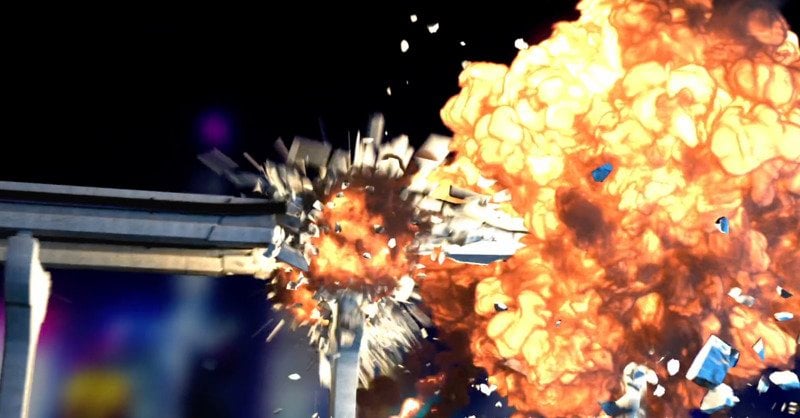Meet Ulysses, a former software developer who recently took the Houdini FX Course at CG Spectrum to switch careers into visual effects, working as a Pipeline Technical Director/Technical Artist—a role that balances creative and technical skills.
We chat with him about finding his dream job, how his CG Spectrum mentor helped him break into the industry, and what he loved about learning SideFX Houdini.
Hi Ulysses! Tell us about yourself and what drew you to visual effects?
Hello, there! When I was a teenager I made small scenes in Maya in between learning how to code and taking part in my school’s theatre program. It wasn’t until many years later, after university and working a full-time job as a software developer, that I gradually shifted back to 3D as a freelance programmer. For a number of years, my focus was on building software around real-time 3D experiences while moonlighting as a LiveCode Concert Visualist.
I moved back to London and, after realizing how big the VFX industry was there, I figured it was a good time to combine my interest in 3D graphics, software, and performance and pursue a career in VFX! It’s a way of telling stories through artistic choices while pushing technological limits.
Ulysses’ showreel, including work he completed at CGS, demonstrates some examples of technical art.
How did your previous studies and experience as a software engineer help you learn Houdini as part of CG Spectrum's FX Course?
Being a software engineer means breaking down a problem into smaller chunks that a computer can digest. A complicated visual effects shot requires a similar sort of logic—if there was one node that could do all the FX we’d be out of a job!
When approaching either role, I start with my final result then figure out what are the components that go into it, then construct a network backward. My mentor, Ben Fox, was instrumental in helping me bridge this logic gap.
While working on the tea pouring shot for my reel, I initially started with the teapot and was having a lot of difficulties until he told me to start with the liquid sim as that’s the most important part of the shot.
On a more practical note, a lot of my work as a freelancer was in TouchDesigner. TouchDesigner branched out from an early version of SideFX Houdini, so the terminology is very similar. The primary differences are that TouchDesigner is real-time and focuses on 2D. If someone is a Houdini artist who wants to get better at CHOPs or has an interest in real-time graphics, I’d highly recommend giving TouchDesigner a go.

No FX showreel would be complete without an awesome explosion!
Tell us about your experience at CG Spectrum—what challenges did you face?
Coming from an industry adjacent to VFX, I was expecting the transition to be a lot easier. While, as a pipeline TD [pipeline technical director], I felt at home with the technical side of things, it took me a lot of time to find visual expression in the work I was doing—the more technical artist side of things. There are many hours of lookdev that go into every shot on a reel from tweaking simulations in Houdini to compositing in Nuke.
Talk us through your favorite project as part of the Houdini FX course.
My favorite project was the Vellum project in the final semester. It culminated in the “walking man” shots on my reel and was a really useful exploration of both technique and artistic expression. It started with a concept of focused effects coming down on the figure, but through discussions with Ben, I went for a treadmill effect where the ground is disappearing behind them. Both the leaves and the snow were done in Vellum and it provided a good exploration ground for collisions with animated geometry.
Congratulations on your new job at visual effects studio, Electric Theater Collective (ETC)! What does a Pipeline TD/Technical Artist do?
Thank you! At the moment I’m learning about the production pipeline side of things—getting comfortable with what departments use which technology, the way a shot moves through production, how the farm is managed, and the way their internal tools are plugged into the various DCCs.
I’m really excited about the opportunity to work with a company that’s growing quickly and receiving more and more accolades for their innovative VFX work in advertising.
My day-to-day so far has consisted of writing small changes to internal tools and talking to artists to gather requirements for a larger tool.
This role was created especially for you, which is so cool! How did this come about?
I applied for a “CG Generalist” position, and my resume and reel intrigued them enough to call me in for an interview. During the interview, we chatted about my background and what I’m interested in going forward.
They wanted to support my interests while utilizing my skills as a developer, and so they created a new role for me.
They already have a few artists who also do technical things, so it wasn’t a huge leap for them to go the other way around, and ETC is fully supportive of their team’s career goals.
Your role as a Technical Artist/Pipeline TD intersects between creative and technical—can you explain the main differences between both but also how they work together?
The role of a pipeline TD (the technical side) is mainly pipeline-oriented—updating and fixing their internal tools, making production data visualization tools, etc. The role of a technical artist (the creative side) will be as an FX artist working on a show.
The hope is that after working on a show and getting first-hand experience with the pipeline tools I’ll be more informed about how tools can be updated or changed to better accommodate artist needs.
How did studying at CG Spectrum prepare you for your new role at Electric Theater Collective?
CG Spectrum gave me a deep practical knowledge of the tool I like working with the most—Houdini. My mentor, Ben Fox, also encouraged my ambitions related to building tools for the projects that I was working on.
While at CG Spectrum, I built a lego tool for converting a model into a lego object, a tool for showing statistics on rendered frames, and one for wedging simulations to see side-by-side results.
All of these tools have provided valuable experience that helps me day-to-day at ETC.

Lego generator by Ulysses, done in Houdini.
What advice would you give someone looking to become a Pipeline TD/Technical Artist or for a role that strikes a balance between creative and technical skills?
If you want to get better at the technical side I’d highly recommend the CGWiki Joy of Vex series and a general Python programming course.
The best advice I can give is to follow what you like doing best and let those activities dictate which jobs you try and get hired for!
I found myself splitting my time between programming tools and making short FX pieces so this job is perfect for me.
Want to become a technical artist, a role that is both technical and creative?
At CG Spectrum, we'll show you what a technical artist is, and how to become one! Our FX courses give you the skills you need to think creatively while also being able to solve difficult technical problems. These skills are vital in landing your dream job in the film and games industry.
Led by industry experts, like Ulysses' mentor Ben Fox, you'll receive accelerated training and personalized feedback to help get you industry-ready sooner. Follow your passions, invest in your talents, and see where they take you!
Related Links




